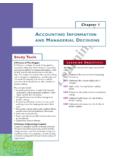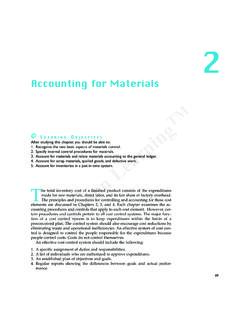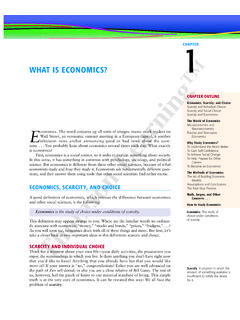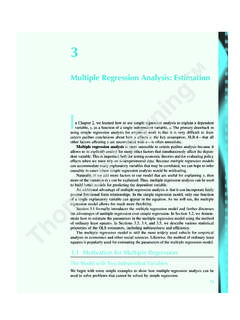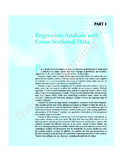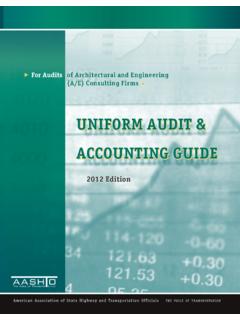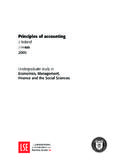Transcription of RECOGNIZING A MINORITY INTEREST IN CONSOLIDATED …
1 RECOGNIZING A MINORITY INTERESTIN CONSOLIDATED FINANCIAL STATEMENTSLEARNING OBJECTIVEA dapt the consolidation work sheet procedure to recognize a MINORITY 11 illustrates the consolidation procedure when the parent owns 100 percent of a subsidiary. Parentcompanies may, however, own less than 100 percent for several parent can gain control of a subsidiary with a smaller capital investment and therefore put less cap-ital at risk to loss. Parent companies generally gain control of a subsidiary when the ownership percent-age exceeds 50 percent. A 51 percent investment in a subsidiary requires less capital than a 100 shareholders of the subsidiary may be unwilling to sell their shares, so the parent cannot acquire100 MINORITY INTEREST exists whenever a parent company owns a controlling INTEREST in a subsidiary butdoes not own 100 percent. The remaining shareholders in the subsidiary constitute the MINORITY INTEREST .
2 Theseminority shareholders have a claim on the earnings and net assets of the subsidiary. The CONSOLIDATED bal-ance sheet includes all of the assets and liabilities of a subsidiary, not just an amount equal to the parent sownership percentage. Likewise, the CONSOLIDATED income statement includes all of the revenues and expensesof a subsidiary, not just an amount equal to the parent s ownership percentage. The parent s controllinginterest permits it to manage all of the net assets of a subsidiary, justifying the inclusion of 100 percent ofthe subsidiary s assets, liabilities, revenues, and expenses in the CONSOLIDATED financial statements. The parentcompany does not, however, have a claim on 100 percent of the net assets or earnings. The consolidatedfinancial statements must therefore recognize the claim of the MINORITY shareholders. We illustrate belowthe procedures to prepare a consolidation work sheet when a MINORITY INTEREST OF MINORITY INTEREST AT THE DATE OF ACQUISITIONR efer to the data in Chapter 11 for Company P and Company S in Appendix Recall that Company Pacquired 100 percent of the outstanding shares of Company S for $650,000 on January 1, Year 1.
3 At thetime of acquisition, the book value of the shareholders equity of Company S was $650,000, comprising thefollowing account balances:COMPANY S, JANUARY 1, YEAR 1 Common Stock ..$500,000 Retained Earnings .. 150,000 Total Shareholders Equity ..$650,000 Assume now that Company P acquired only 80 percent of the outstanding common stock of Company Sand paid $520,000. Exhibit 1 shows the claims of Company P and of the MINORITY shareholders on the netassets of Company S on the date of worksheet entry to eliminate the Investment in Company S account, which appears on the books ofCompany P, is as follows: Common Stock (Company S) ..400,000 Retained Earnings (Company S) ..120,000 Investment in Company S (Company P) ..520,000 The work sheet entry to recognize the MINORITY INTEREST claim on the net assets of Company S is as follows:Common Stock (Company S) ..100,000 Retained Earnings (Company S).
4 30,000 MINORITY INTEREST in Net Assets of Company S( CONSOLIDATED Balance Sheet) ..130,000 The account MINORITY INTEREST in Net Assets of Company S does not appear on the books of either , the work sheet entry above creates this account. The CONSOLIDATED balance sheet includes all of theassets and liabilities of Company P (except the Investment in Company S account eliminated in the first entryabove) and of Company S. The 20 percent claim of the MINORITY shareholders against the net assets ofCompany Sof $130,000 typically appears between liabilities and shareholders equity on the CONSOLIDATED bal-ance Note. A conceptual issue arises regarding the valuation of the MINORITY INTEREST in the netassets of a subsidiary when the parent paid more than the book value of the subsidiary s net assets on thedate of the MINORITY INTEREST reflect the book values on the subsidiary s books, the MINORITY INTEREST reflect the market values of the subsidiary s net assets implied by the pricepaid by the parent for its INTEREST in the subsidiary?
5 To understand this issue, assume in the example above that Company P had paid $560,000 instead of$520,000 for its 80 percent INTEREST in Company S. Using the book values of Company S s net assets yieldsa MINORITY INTEREST of $130,000 [= .20 ($500,000 + $150,000)]. The implied market value of the net assetsof Company S is $700,000 (= $560,000/.8). Using the market values of Company S s net assets yields aminority INTEREST of $140,000 (= .2 $700,000). Proponents of using book values of the subsidiary s net assets view CONSOLIDATED financial statements fromthe parent s viewpoint. The parent paid $40,000 more than book value for its 80 percent INTEREST . The minor-ity shareholders did not pay an additional $10,000 for their INTEREST in the undervalued assets. The minorityinterest should therefore equal $130,000. Proponents of using market values of the subsidiary s net assetsview CONSOLIDATED financial statements from both the parent s and the MINORITY INTEREST s viewpoint.
6 The netassets of Company S have a market value exceeding their book value of $50,000 (= $700,000 $650,000).If Company S were to sell its net assets for their market value, the MINORITY shareholders would have aclaim on 20 percent of the proceeds, or $140,000 (= .2 $700,000). RECOGNIZING a MINORITY INTEREST in CONSOLIDATED Financial Statements2 EXHIBIT 1 Allocation of Shareholders Equity of Company Sto Company P and the MINORITY Shareholderson the date of acquisitionTo MinorityTo Company PShareholdersTotal(80 percent)(20 percent)(1)(2)(3)Common Stock ..$500,000$400,000$100,000 Retained Earnings ..150,000120,00030,000 Total Shareholders Equity ..$650,000$520,000$130,000 Generally accepted accounting principles (GAAP) currently follow the first approach. Thus, in the exam-ple above, the consolidation work sheet shows a write-up of Company S s net assets, the recognition ofgoodwill, or both, for the $40,000 excess price paid by P Company.
7 It does not recognize the additional$10,000 in the valuation of S Company s net assets and in the valuation of the MINORITY INTEREST . Recent dis-cussions within the Financial accounting Standards Board (FASB) suggest a preference toward the secondapproach to measuring the MINORITY INTEREST , but the FASB has not yet issued a pronouncement requiringthis OF MINORITY INTERESTSUBSEQUENT TO DATE OF AQUISITIONC ontinuing the example above, column (1) of Exhibit 2 shows the change in shareholders equity of CompanyS between January 1, Year 1 and December 31, Year 4. Company S generated earnings in excess of dividendsof $7,000 during Year 1, Year 2, and Year 3 and net income of $48,000 during Year 4. Columns (2) and (3)show the allocation of total shareholders equity to the 80 percent INTEREST of Company P and the 20 percentinterest of the MINORITY shareholders. EXHIBIT 2 Allocation of Shareholders Equity of Company Sto Company P and the MINORITY Shareholderson December 31, Year 4To MinorityTo Company PShareholdersTotal(80 percent)(20 percent)(1)(2)(3)Common Stock.
8 $500,000$400,000$100,000 Retained Earnings:January 1, Year 1 ..150,000120,00030,000 Increase in Retained Earnings, January1, Year 1 to December 31, Year 3 ..7,0005,6001,400 Net Income for Year 4 .. 48,000 38,400 9,600 December 31, Year 4 ..$205,000$164,000$ 41,000 Total Shareholders Equity ..$ $564,000$141,000 Company P initially recorded its investment in Company S at its cost on January 1, Year 1, of $520, P increased the account Investment in Company S by $7,000 between Year 1 and Year 3 for its80 percent share of Company S s earnings in excess of dividends. Company P increased the investmentaccount by $48,000 during Year 4 for its share of earnings. The account Investment in Company S has abalance of $564,000 on December 31, Year 4. The work sheet entry to eliminate the investment account issimilar to that discussed in Chapter 11 except that the entry eliminates only 80 percent of the shareholders equity of Company Stock (Company S).
9 400,000 Retained Earnings (Company S) ..125,600 Equity in Earnings of Company S (Company P) ..38,400 Investment in Company S (Company P) ..564,000 The MINORITY INTEREST in Company S has likewise increased from $130,000 on January 1, Year 1, to$141,000 on December 31, Year 4. As indicated above, the account MINORITY INTEREST in Net Assets ofCompany S does not appear on the books of either Company P or Company S. The consolidation worksheet procedure creates this account. Thus, changes in the MINORITY INTEREST claim appear in consolidatedfinancial statements as a result of entries on the consolidation work sheet. The entry to eliminate the remainingRecognizing a MINORITY INTEREST in CONSOLIDATED Financial Statements320 percent of the shareholders equity accounts of Company S and to recognize the MINORITY INTEREST s claimon earnings and net assets is as follows:Common Stock (Company S) ..100,000 Retained Earnings (Company S).
10 31,400 MINORITY INTEREST in Earnings of Company S ( CONSOLIDATED Income Statement) ..9,600 MINORITY INTEREST in Net Assets of Company S ( CONSOLIDATED Balance Sheet) ..141,000 The account MINORITY INTEREST in Net Assets of Company S appears on the CONSOLIDATED balance sheet. Thisaccount reports the MINORITY INTEREST claim on the net assets of Company S on December 31, Year 4. Theaccount MINORITY INTEREST in Earnings of Company S appears on the CONSOLIDATED income statement. Theconsolidated income statement includes all of the revenues and expenses of Company P and Company claim of the MINORITY shareholders on the earnings of Company S appears as a subtraction (note thedebit balance in this account) from the combined earnings of Company P and Company S when computingconsolidated net 3 presents the consolidation work sheet reflecting the two entries above, as well as the elimina-tion of intercompany sales, receivables, and a MINORITY INTEREST in CONSOLIDATED Financial Statements4 EXHIBIT 3 COMPANY P AND COMPANY SWork Sheet to Derive CONSOLIDATED FinancialStatements Based on Data from PreclosingTrial Balances for Year 4 Adjustments andP and SCompany PCompany SEliminationsConsolidatedDebitCreditDebi tCreditDebitCreditDebitCreditTrial Balance AccountsAccounts Receivable$ 200,000$ 25,000(2) $12,000 $ 213,000 Investment in Stock ofCompany S564,000 (1)
